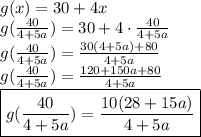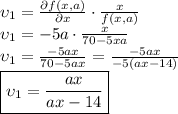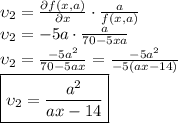
Mathematics, 14.09.2019 06:30 JotaroKujo6233
consider the two functions:
f(x, a) =70- 5xa & g(x) = 30 +4x
a) find the x value of the point where the two equations intersect (in terms of the variable a)
b) find the value of the functions at the point where the two equations intersect (in terms of the variable a).
c) take the partial derivate of f with respect to x, \partial f / \partial x, and with respect to a, \partial f / \partial a
d) what are the values of these derivatives , when x= 3 and a=2, which can be written as \partialf /\partialx (3,2) and \partial f /\partiala (3,2)
e) next caculate these two numbers:
\upsilon1 = (\partialf /\partialx ( 3,2)) 3 / f (3,2)
\upsilon2 = (\partialf /\partiala ( 3,2)) 2 / f (3,2)
f) finally write out these equations in term of a and x and simplify,
\upsilon1 = (\partialf /\partialx ( x, a)) x / f (x, a)
\upsilon2 = (\partialf /\partialx ( x, a)) a / f (x, a)

Answers: 3


Other questions on the subject: Mathematics

Mathematics, 21.06.2019 16:30, puremousetail
In two or more complete sentences describe how to determine the appropriate model for the set of data, (1,1), (3,2), (6,3), (11,4).
Answers: 1

Mathematics, 21.06.2019 16:40, lawrencebenoit7194
This question awards 100 ! i really don’t want to fail i will also mark you !
Answers: 2

Mathematics, 21.06.2019 21:30, gonzalezashley152
In a test for esp (extrasensory perception), the experimenter looks at cards that are hidden from the subject. each card contains either a star, a circle, a wave, a cross or a square.(five shapes) as the experimenter looks at each of 20 cards in turn, the subject names the shape on the card. when the esp study described above discovers a subject whose performance appears to be better than guessing, the study continues at greater length. the experimenter looks at many cards bearing one of five shapes (star, square, circle, wave, and cross) in an order determined by random numbers. the subject cannot see the experimenter as he looks at each card in turn, in order to avoid any possible nonverbal clues. the answers of a subject who does not have esp should be independent observations, each with probability 1/5 of success. we record 1000 attempts. which of the following assumptions must be met in order to solve this problem? it's reasonable to assume normality 0.8(1000), 0.2(1000)%30 approximately normal 0.8(1000), 0.2(1000)% 10 approximately normal srs it is reasonable to assume the total number of cards is over 10,000 it is reasonable to assume the total number of cards is over 1000
Answers: 1
You know the right answer?
consider the two functions:
f(x, a) =70- 5xa & g(x) = 30 +4x
a) find the x value o...
f(x, a) =70- 5xa & g(x) = 30 +4x
a) find the x value o...
Questions in other subjects:



Biology, 12.12.2020 17:00



Mathematics, 12.12.2020 17:00




Mathematics, 12.12.2020 17:00



 is
is  and the partial derivative of f with respect to
and the partial derivative of f with respect to  is
is 
 and
and 
 and
and 
 and
and 
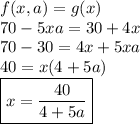
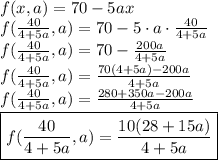
 :
: